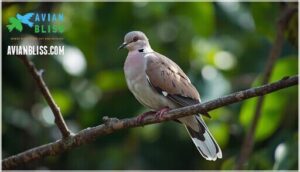This site is supported by our readers. We may earn a commission, at no cost to you, if you purchase through links.

This secretive bird measures around 10-12 inches long, sports warm brown plumage with a pinkish chest, and prefers staying hidden in lowland forests from Texas to Argentina.
Unlike other doves, it’s a loner that rarely flocks, foraging quietly through leaf litter for seeds and berries while producing distinctive deep "whooo-uh" calls at dawn and dusk.
Understanding its specific habitat preferences and feeding patterns reveals why this widespread dove remains so elusive to many birdwatchers.
Table Of Contents
- Key Takeaways
- Description of The White-Tipped Dove
- Habitat and Behavior
- Diet and Feeding Habits
- Vocalizations and Identification
- Range and Distribution
- Frequently Asked Questions (FAQs)
- What is a white tipped dove?
- Where do white tipped doves live?
- What is the difference between a white tipped dove and a red dove?
- Does a white tipped dove have a red eye ring?
- What is the difference between a mourning pigeon and a White Wing Dove?
- Where do white tipped pigeons live?
- How to identify a white-tipped dove?
- What is the difference between white wing and white tip?
- Are there any White-tipped Doves in Texas?
- How rare is a White-winged Dove?
- Conclusion
Key Takeaways
- You’ll identify this robin-sized dove by its distinctive white-tipped tail feathers that flash during flight and warm brown plumage with a pinkish chest.
- You can find white-tipped doves throughout the Americas from southern Texas to Argentina, where they prefer dense lowland forests and woodland edges.
- You’ll hear their deep "whooo-uh" calls at dawn and dusk, as these solitary birds rarely flock and spend most time foraging quietly through leaf litter.
- You’ll have better success spotting them by focusing your search on forest floors during early morning or late afternoon hours, since nearly 80% of sightings occur within 50 feet of dense vegetation.
Description of The White-Tipped Dove
You’ll recognize this member of the Columbidae family by its distinctive features that set it apart from other dove species.
The whitetipped dove measures 9.8 to 12.2 inches in length, making it larger than a Mourning Dove but smaller than a Rock Pigeon. Its portly build includes a small head, short rounded tail feathers, and stubby legs that give it a robin-like appearance.
The plumage color displays subtle elegance with pale brown to grayish tones across the back, while the chest and belly show a gentle pinkish hue. What really catches your eye are those prominent white tips on the outer tail feathers—they’re like nature’s built-in identification tags, especially visible during flight.
Those signature white tail-feather tips flash like beacons when the dove takes flight—nature’s perfect calling card
The bird’s deep red eye color creates a striking contrast against its muted feathers. This dove identification becomes easier when you notice the beak shape is typical of seed-eating birds, and the body size ranges from 3.5 to 8.1 ounces, making these dove characteristics quite manageable for field observation.
Understanding the various dove species types can also aid in recognizing the unique features of the White-Tipped Dove.
Habitat and Behavior
White-tipped doves frequently inhabit lowland forests, secondary growth areas, and woodland edges throughout their range.
You’ll find them in dense understory vegetation where they can easily hide from predators.
These ground-dwelling birds display fascinating social structure and nesting habits:
- Territorial behavior: They defend small areas vigorously during breeding season using calls and displays
- Daily patterns: Peak activity occurs during early morning and late afternoon when they forage
- Site loyalty: They often remain in the same area year-round unless disturbed
- Urban adaptation: They tolerate moderate human presence if adequate cover exists.
Their foraging patterns involve walking through low vegetation rather than flying.
When threatened, they quickly dart into dense cover.
During breeding season, males perform elaborate courtship displays while both parents share nest-building duties in concealed locations.
Understanding bird habitat preferences is essential for conservation efforts.
Habitat preservation remains vital as these doves struggle in heavily fragmented landscapes, making dove habitat protection essential for population stability.
Diet and Feeding Habits
Understanding how these doves fuel their bodies opens a window into their survival strategies.
White-tipped doves are masters of ground-level dining, spending most daylight hours walking through leaf litter with their characteristic head-bobbing gait. Their granivorous diet forms the backbone of their nutrition, though they’re far from picky eaters.
These feathered ground-walkers turn every forest floor into their personal buffet, methodically pecking through nature’s scattered feast
Key Dietary Components:
- Seeds – Primary food source from grasses, mesquites, and elms
- Fruits and berries – Hackberries, prickly pear cactus, and wild fruits
- Insects – Butterflies, moths, and snails for protein boosts
- Grit – Small stones that aid seed digestion
Their foraging strategies showcase remarkable adaptability. You’ll spot them pecking methodically through woodland floors, rarely forming feeding flocks like other dove species.
During breeding season, insect eating increases dramatically as parents need extra protein for developing chicks. Bird feeding enthusiasts can attract them using platform feeders stocked with milo, sorghum, or sunflower seeds.
This opportunistic approach to dove feeding habits allows them to thrive in both wild habitats and cultivated gardens, making their foraging behavior a key factor in their widespread success. The White-Tipped Dove’s diet and feeding patterns are essential to understanding their ecological role.
Vocalizations and Identification
Through dense undergrowth or open clearings, you’ll recognize White-tipped Doves by their distinctive Call Patterns. Listen for their deep "whooo-uh" or "ooo-whoop" – these dove sounds echo at dawn and dusk when birds are most active.
Unlike other Dove Songs, this species produces fuller, less rhythmic notes that serve as reliable Identification Tips. The vocalizations range from 500-700 Hz, creating that signature muffled quality you won’t confuse with sharper dove calls.
Males repeat their song up to 10 times per minute during breeding season, making Bird Recognition straightforward through Vocal Learning. Both sexes call, though males vocalize more boldly when claiming territory.
This WhiteTipped Dove often sings from low perches, helping you pinpoint their location. Audio playback typically triggers immediate responses, confirming your bird identification in the field through their species-specific vocal behavior.
Understanding bird vocalization changes is essential for effective bird recognition and conservation efforts.
Range and Distribution
From southern Texas to central Argentina, you’ll find the Whitetipped Dove across an impressive Geographic Spread that makes it the most widespread dove species in the Americas.
This Neotropical birds champion doesn’t follow typical Migration Patterns – instead, it’s a year-round resident with strong site fidelity throughout its massive Habitat Range.
Distribution Maps reveal populations from sea level to 10,500 feet, with Regional Variations among 12-14 subspecies showing subtle differences.
The species thrives in South American birds communities and extends through Mexico, Central America, and even offshore islands like Trinidad.
Unlike many bird distribution patterns, these doves stay put in their territories, adapting to everything from tropical forests to suburban gardens, making bird range identification straightforward for birders.
The White-tipped Dove’s presence in the Yucatan Peninsula is characterized by its preference for tropical lowland forests and agricultural areas.
Frequently Asked Questions (FAQs)
What is a white tipped dove?
You’ll spot a white-tipped dove as a robin-sized bird with pale brown plumage and distinctive white tail tips.
They’re ground-foragers found throughout the Americas, from Texas to Uruguay, preferring woodlands and urban gardens.
Where do white tipped doves live?
You’ll find these doves throughout the Americas, from southern Texas stretching all the way down to Uruguay.
They’ve adapted well to forests, woodlands, scrublands, and even your neighborhood parks and gardens.
What is the difference between a white tipped dove and a red dove?
You’ll notice key differences between these dove species right away.
White-tipped doves have pale brown-gray plumage with distinctive white outer tail feather tips, while red doves display reddish-brown coloration throughout their bodies without white tail markings.
Does a white tipped dove have a red eye ring?
Absolutely breathtaking! You’ll spot deep red eyes in white-tipped doves, but they don’t have red eye rings around those striking crimson irises. The red coloration stays within the eye itself.
What is the difference between a mourning pigeon and a White Wing Dove?
You’ll notice key differences between these dove species in size, coloring, and wing patterns.
Mourning Doves are slender with pointed tails and brown plumage, while White-winged Doves are stockier with prominent white wing patches visible during flight.
Where do white tipped pigeons live?
Like scattered travelers following ancient migration paths, these doves roam from southern Texas through Central America to Uruguay.
You’ll spot them in forests, woodlands, scrublands, and urban gardens across the Americas, thriving from sea level to 1,700 meters elevation.
How to identify a white-tipped dove?
Look for a robin-sized dove with distinctive white tips on its outer tail feathers that flash during flight.
You’ll spot pale brown-gray plumage, a pinkish chest, deep red eyes, and a characteristically small head with short legs, which are key features to identify the bird, along with its distinctive white tips.
What is the difference between white wing and white tip?
White-wing doves have white patches on their wings that you’ll see when they fly.
White-tipped doves show white tips on their tail feathers instead.
You’ll spot the wing patches versus tail markings easily during flight.
Are there any White-tipped Doves in Texas?
Surprisingly, you’ll find these elusive birds right in your backyard! White-tipped Doves thrive throughout southern Texas, from March through September, nesting in dense vegetation and foraging on seeds.
How rare is a White-winged Dove?
White-winged Doves aren’t particularly rare.
You’ll spot them regularly across the southwestern United States, especially in desert areas with cacti.
Their populations have actually grown and expanded northward in recent decades, making them quite common.
Conclusion
Nearly 80% of white tipped dove sightings occur within 50 feet of dense forest floors, highlighting their ground-dwelling nature.
You’ll find success spotting this elusive species by focusing your search efforts in lowland forests during dawn and dusk hours.
Listen for their distinctive "whooo-uh" calls and watch for those characteristic white-edged tail feathers.
With patience and the right habitat knowledge, you’ll add the white tipped dove to your birding list.








